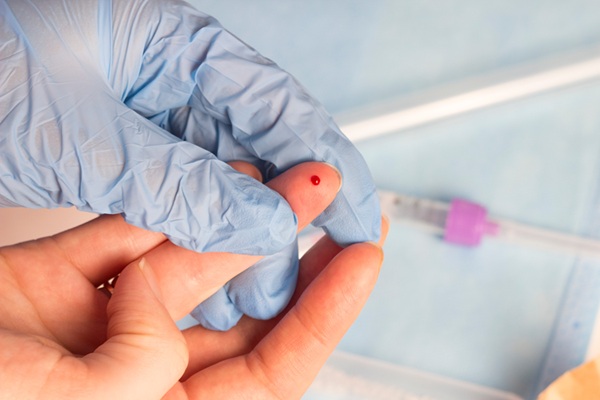Finger Prick Test Could Transform Heart Attack Prevention
|
By HospiMedica International staff writers Posted on 14 Feb 2025 |

Currently, blood-thinning medications are prescribed only to patients who have already experienced a heart attack or stroke, as these drugs can lead to serious bleeding in some individuals. Due to the lack of a reliable method to predict who may benefit or be harmed by these medications, doctors have been unable to prescribe them preventively to high-risk patients. Now, a new study suggests that a simple scoring system could transform how doctors prevent heart attacks and strokes by identifying patients who are most likely to benefit from preventive treatment.
The innovative test, known as the TRIPLE Score, was developed by researchers at the University of Reading (Berkshire, UK). It measures specific proteins on blood platelets, along with the patient's age, to help doctors make better-informed decisions about prescribing blood-thinning medications like aspirin and clopidogrel. Although the test is not yet widely available, the goal is to eventually make it suitable for point-of-care use. It will be incorporated into patient studies to verify its potential to enhance care.
In their study, published in Circulation Research, the team demonstrated that the TRIPLE Score effectively identified patients whose blood was more prone to forming clots in laboratory tests. The findings also correlated with established risk scores used by doctors to estimate a patient’s likelihood of having a heart attack within the next 10 years. The test requires just a small blood sample and could be developed into a simple tool that healthcare providers, not just specialists, could use in practice.
“Our new test will help doctors make sure that patients receive the best treatment and keep their quality of life,” said Dr. Alexander Bye, lead author of the research at the University of Reading. “Next, we aim to make the test even easier to use by developing a finger prick test, so that it as simple as measuring blood glucose."
Latest Point of Care News
Channels
Critical Care
view channel
Groundbreaking Technology Rapidly Detects Airborne Influenza Viruses
Influenza, caused by the influenza virus, poses a significant health risk, particularly in confined spaces. Now, a new, cutting-edge technology promises to enhance the early detection of airborne viruses... Read more
Flexible Semi-Autonomous Robot Could Deliver Medicine Inside Body
Soft robotics, in contrast to traditional rigid robots, are composed of flexible materials that mimic the movements of living organisms. This inherent flexibility makes them well-suited for navigating... Read moreSurgical Techniques
view channel
New Class of Bioadhesives to Connect Human Tissues to Long-Term Medical Implants
Medical devices and human tissues differ significantly in their composition. While medical devices are primarily constructed from hard materials like metal and plastic, human tissue is soft and moist.... Read more
New Transcatheter Valve Found Safe and Effective for Treating Aortic Regurgitation
Aortic regurgitation is a condition in which the aortic valve does not close properly, allowing blood to flow backward into the left ventricle. This results in decreased blood flow from the heart to the... Read more
Minimally Invasive Valve Repair Reduces Hospitalizations in Severe Tricuspid Regurgitation Patients
The tricuspid valve is one of the four heart valves, responsible for regulating blood flow from the right atrium (the heart's upper-right chamber) to the right ventricle (the lower-right chamber).... Read morePatient Care
view channel
Portable Biosensor Platform to Reduce Hospital-Acquired Infections
Approximately 4 million patients in the European Union acquire healthcare-associated infections (HAIs) or nosocomial infections each year, with around 37,000 deaths directly resulting from these infections,... Read moreFirst-Of-Its-Kind Portable Germicidal Light Technology Disinfects High-Touch Clinical Surfaces in Seconds
Reducing healthcare-acquired infections (HAIs) remains a pressing issue within global healthcare systems. In the United States alone, 1.7 million patients contract HAIs annually, leading to approximately... Read more
Surgical Capacity Optimization Solution Helps Hospitals Boost OR Utilization
An innovative solution has the capability to transform surgical capacity utilization by targeting the root cause of surgical block time inefficiencies. Fujitsu Limited’s (Tokyo, Japan) Surgical Capacity... Read more
Game-Changing Innovation in Surgical Instrument Sterilization Significantly Improves OR Throughput
A groundbreaking innovation enables hospitals to significantly improve instrument processing time and throughput in operating rooms (ORs) and sterile processing departments. Turbett Surgical, Inc.... Read moreHealth IT
view channel
Printable Molecule-Selective Nanoparticles Enable Mass Production of Wearable Biosensors
The future of medicine is likely to focus on the personalization of healthcare—understanding exactly what an individual requires and delivering the appropriate combination of nutrients, metabolites, and... Read more
Smartwatches Could Detect Congestive Heart Failure
Diagnosing congestive heart failure (CHF) typically requires expensive and time-consuming imaging techniques like echocardiography, also known as cardiac ultrasound. Previously, detecting CHF by analyzing... Read moreBusiness
view channel
Expanded Collaboration to Transform OR Technology Through AI and Automation
The expansion of an existing collaboration between three leading companies aims to develop artificial intelligence (AI)-driven solutions for smart operating rooms with sophisticated monitoring and automation.... Read more



















